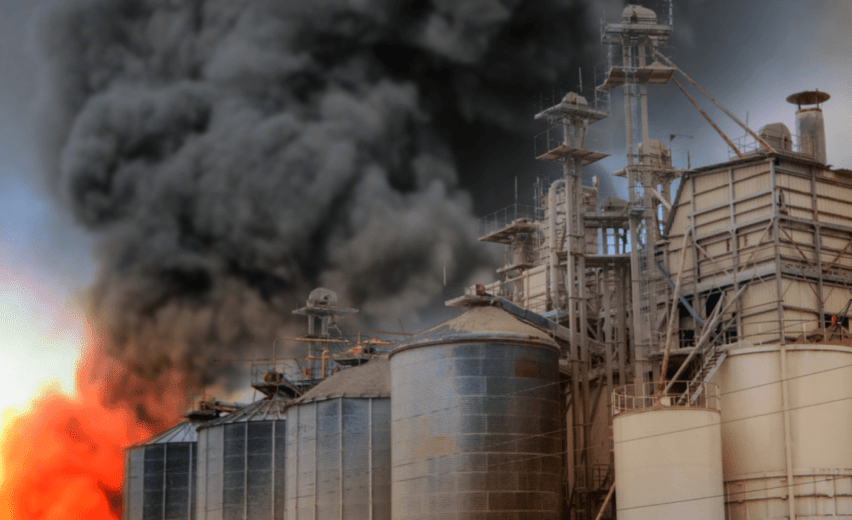Operations involving the handling, processing, or storage of flammable materials create the conditions for the formation of explosive atmospheres.

The study of the characteristics and challenges associated with explosive atmospheres is essential in various industrial sectors, such as oil and gas, mining, chemical, food, and pharmaceuticals.
These environments present specific risks related to the presence of flammable or combustible substances, which require rigorous safety measures. Understanding the specific characteristics and adopting appropriate safety practices are crucial to protect lives, facilities, and assets in these industries.
Here are some characteristics related to explosive atmospheres in industrial environments:
Presence of Flammable Substances: Explosive atmospheres contain flammable substances, such as gases, vapors, flammable liquids, or combustible dust. The presence of these substances is the primary factor that makes the atmosphere potentially explosive.
Proper Mixture of Flammable Substances and Oxygen: For an explosion to occur, a proper mixture of flammable substances and oxygen from the air is required. This is often referred to as the “flammability limit.” The mixture must be within a specific range to be explosive.
Source of Ignition: Industrial environments have various equipment, systems, and installations that can generate a source of ignition, such as sparks, open flames, electricity, intense heat, or hot surfaces. Ignition sources can be classified as intrinsic (natural) or extrinsic (external). Therefore, in these environments, it is of utmost importance to have certified and suitable equipment for potentially explosive atmospheres.
Conditions of Processing or Operation: Industrial operations involving the handling, processing, or storage of flammable substances create the conditions for the formation of explosive atmospheres. This can occur in various sectors, such as oil and gas, chemicals, mining, food, and pharmaceuticals.
Pressure and Temperature: Given the presence of multiple pieces of equipment and boilers in industrial environments, a significant increase in ambient temperature is quite common, which can influence the formation of explosive atmospheres.
Combustible Dust: In some industries, such as mining and food manufacturing, the presence of combustible dust is an additional factor that can result in explosive atmospheres. Fine dust, such as flour, coal, or powdered chemicals, can be highly flammable.
Leaks and Spills: In environments where the handling, storage, and processing of flammable liquids are common, leaks or spills of these substances can occur. Therefore, it is important to have adequate supervision and control methods for these substances.
Secondary Explosions: It is quite common in industrial environments that in the event of an initial explosion, unburned dust or gases can create a secondary explosive atmosphere, resulting in multiple explosions that can extend over long distances.
Ways to monitor and address the challenges posed by explosive atmospheres in industrial environments:
Norms and Regulations: Each sector has specific regulations related to explosion prevention and safety. In Brazil, the ABNT NBR IEC 60079 standard comprehensively addresses compliance with explosive atmospheres. Therefore, understanding and ensuring regulatory compliance is crucial for facility safety.
Monitoring and Detection: Early detection of flammable gases or combustible particles is essential for explosion prevention. This involves the implementation of monitoring systems, such as gas detectors and fire suppression systems.
Maintenance and Inspection: Equipment and safety systems must be regularly maintained and inspected to ensure proper operation. This requires well-established maintenance programs and working with a certified and qualified inspection and maintenance company.
Training and Awareness: Employee awareness of risks and safety practices is crucial to ensure that everyone understands and follows safety procedures and is aware of the risks.
Change Management: As processes, facilities, and equipment are modified, a robust change management process is needed to assess and mitigate the risks associated with these changes. This is essential for maintaining safety.
Dust Protection: In sectors such as mining and food, combustible dust is an additional risk. Mitigating this risk involves adequate dust suppression systems and proper ventilation structures.
Documentation Requirements: Maintaining detailed records of compliance, incident reports, equipment certificates, and regulatory documentation is essential. This can be a logistical and administrative challenge, but it is crucial to document the safety of facilities in a potentially explosive environment.
Investment in Safety: Ensuring that companies allocate adequate resources for safety is essential. This involves investing in equipment, training, personnel, safety procedures, and contracting specialized companies in the field.
How Comquality Engineering Can Help Your Company:
Here at Comquality, our certification in the ABNT NBR IEC 60079-17 standard is not just an achievement but a solid commitment to safety, quality, and excellence. Trust us to take care of your inspection and maintenance needs in environments with explosive atmospheres. We are ahead of the curve, ready to raise your safety and efficiency standards.
Contact us today and discover how our expertise in the IEC 60079 standard can make a difference in your industry.
📞 71 3622-1255
📩 commercial@comquality.com.br
🌍 www.comquality.com.br